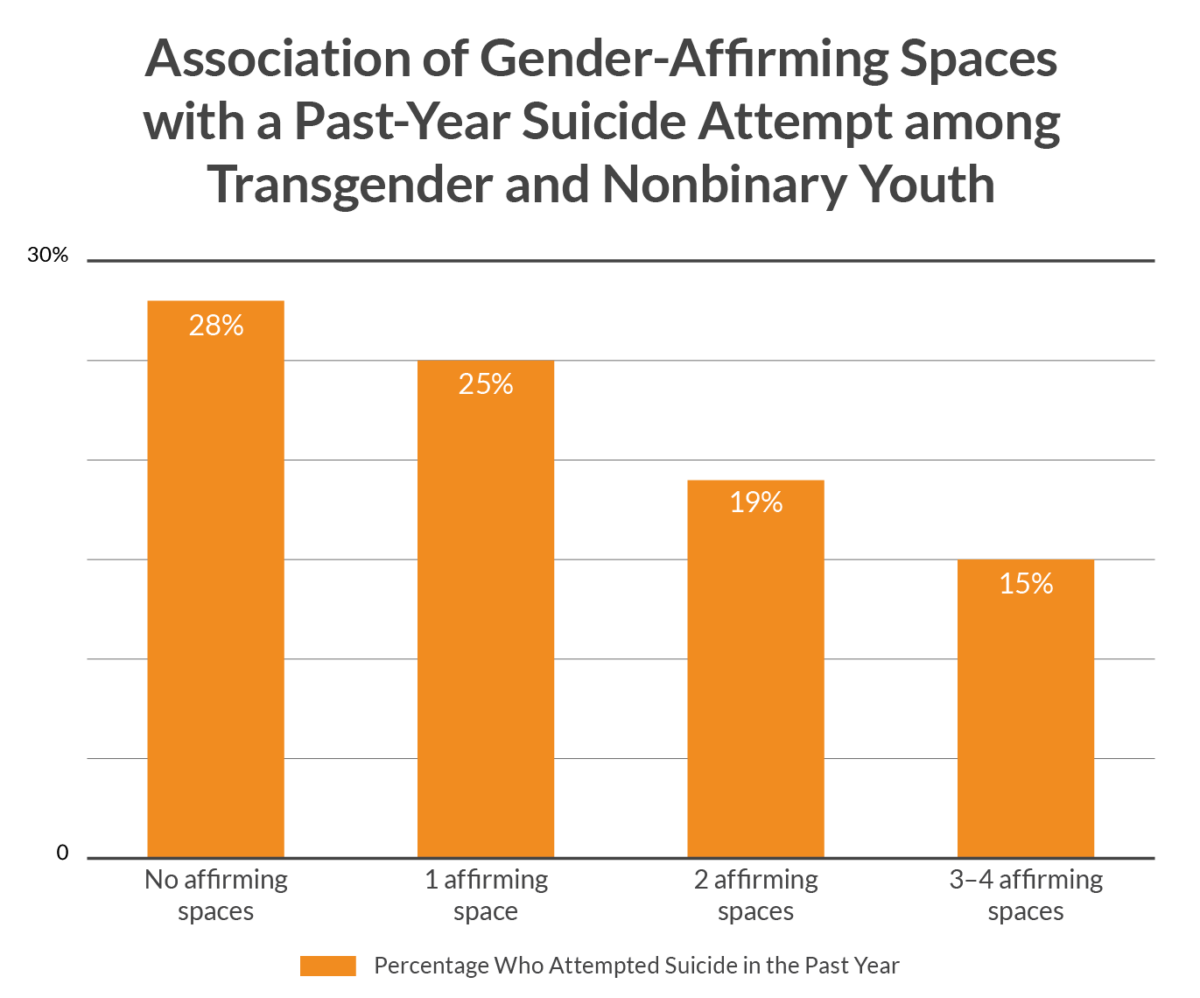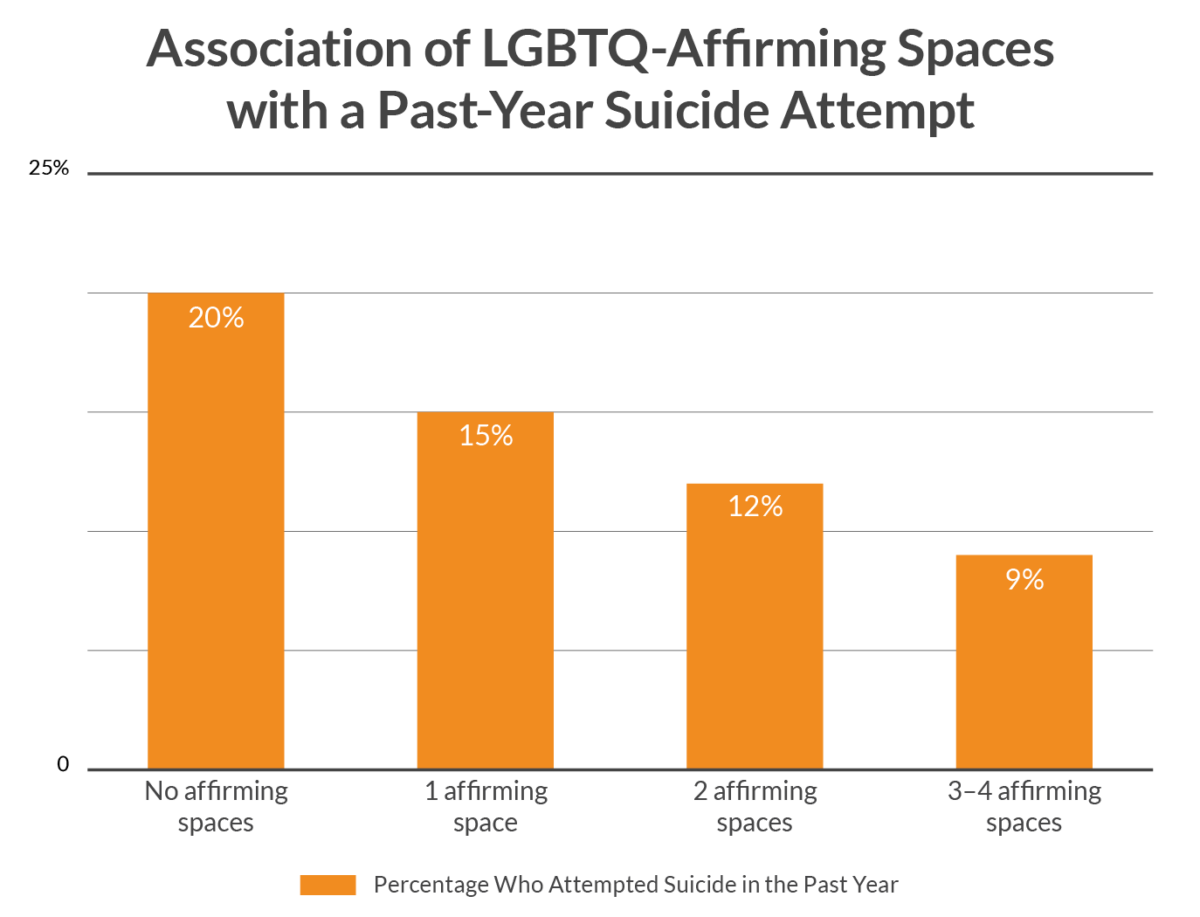Summary
LGBTQ youth are at elevated risk for poor mental health and suicide compared with straight/cisgender peers (Johns et al, 2019; Johns et al., 2020). Because this risk is related to the harmful ways LGBTQ youth are treated, rather than something about being LGBTQ in itself, increased acceptance and affirmation can reduce risk (Meyer, 2016). All LGBTQ youth deserve access to spaces — such as homes, schools, and workplaces — that positively affirm their LGBTQ identity. Unfortunately, not all LGBTQ youth experience acceptance of their identity, and physical distancing policies implemented to minimize the health risks of the COVID-19 pandemic can disrupt access to existing affirming spaces (Green, Price-Feeney, & Dorsion, 2020). This may be particularly true for transgender and nonbinary youth who have increased risk for attempting suicide due in large part to increased exposure to minority stress (Price-Feeney, Green, & Dorison, 2020; Hendricks & Testa, 2012). This brief uses data from The Trevor Project’s 2020 National Survey on LGBTQ Youth Mental Health to examine the association between access to affirming spaces and suicide attempts.
Results
LGBTQ youth who reported having at least one LGBTQ-affirming space had 35% reduced odds of reporting a suicide attempt in the past year (aOR = 0.65).
The strongest association with reduced suicide attempts was for LGBTQ-affirming schools (aOR = 0.62). However, affirming homes (aOR = 0.78), workplaces (aOR = 0.87), and community events (aOR = 0.89) were also individually associated with reduced suicide attempts.
The majority (62%) of LGBTQ youth who were enrolled in school stated that their school was LGBTQ-affirming.
43% of LGBTQ youth reported that home was an LGBTQ-affirming space, 36% (among those employed) reported that their workplace was LGBTQ affirming, and 29% reported that events in their community were LGBTQ-affirming. In addition to the four primary spaces examined, youth were also asked to describe other spaces that were LGBTQ affirming with the top responses being the home of a friend or romantic partner, church, therapy, pride-related events, LGBTQ bars and clubs, and theatre.
Transgender and nonbinary youth who reported having at least one gender-affirming space had 25% reduced odds of reporting a suicide attempt in the past year (aOR = 0.75).
Gender-affirming schools had the strongest association with reduced suicide attempts (aOR = 0.66). Gender-affirming events in the community (aOR = 0.81) and home environments (aOR = 0.85) were also associated with significantly reduced reports of a past-year suicide attempt.
More than half of transgender and nonbinary youth (55%) reported that their school was gender-affirming.
42% of transgender and nonbinary youth reporting that their home was gender-affirming, and 36% reported that events in their community were gender-affirming. More than one-third of transgender and nonbinary youth who were employed said that their work was gender-affirming. The top additional gender-affirming spaces described by transgender and nonbinary youth included the homes of friends and romantic partners, therapy, LGBTQ centers and pride events, conventions, and church.


Methodology
Data was collected from an online survey conducted between December 2019 and March 2020 of 40,001 LGBTQ youth recruited via targeted ads on social media. All LGBTQ youth in the sample were asked to endorse whether or not their home, workplace (if employed), school (if enrolled), and community events were LGBTQ-affirming and given space to describe other LGBTQ-affirming spaces in their lives. Transgender and nonbinary youth were also asked whether each of those four spaces were gender-affirming and provided with space to write-in additional gender-affirming spaces in their lives. Logistic regression models for LGBTQ affirming spaces adjusted for gender identity, age, and race/ethnicity, while those for gender-affirming spaces adjusted for age and race/ethnicity.
Looking Ahead
Affirming environments are associated with reduced suicide risk among LGBTQ youth, including those who are transgender and nonbinary. In this study, affirming school environments were found to have the strongest association with reduced odds of a past-year suicide attempt. Given the changing structure of secondary school environments and college campuses across the U.S. in response to the COVID-19 pandemic, there is a need to ensure that LGBTQ youth continue to have access to spaces that affirm their identities. In places where physical health risks prohibit in-person activities, it remains imperative that this support and affirmation continue through virtual means. The Trevor Project is committed to ensuring that LGBTQ youth are supported throughout the COVID-19 pandemic and beyond by providing 24/7 access to an affirming international community for LGBTQ young people through TrevorSpace as well as trained crisis counselors to talk directly with youth in crisis. Additionally, our advocacy team works to promote policies that lead to the creation of LGBTQ and gender-affirming spaces and our education team provides training to create more inclusive and accepting workplaces, schools, and services for LGBTQ youth.
| ReferencesGreen, A.E., Price-Feeney, M. & Dorison, S.H. (2020). Implications of COVID-19 for LGBTQ Youth Mental Health and Suicide Prevention. New York, New York: The Trevor Project.Hendricks, M., & Testa, R. (2012). A Conceptual Framework for Clinical Work With Transgender and Gender Nonconforming Clients: An Adaptation of the Minority Stress Model. Professional Psychology: Research and Practice, 43(5), 460-467.Johns, M.M., Lowry, R., Andrzejewski, J., Barrios, L.C., Zewditu, D., McManus, T., et al. (2019). Transgender identity and experiences of violence victimization, substance use, suicide risk, and sexual risk behaviors among high school student–19 states and large urban school districts, 2017. MMWR, 68(3), 65-71.Johns M.M., Lowry R., Haderxhanaj L.T., et al. (2020). Trends in violence victimization and suicide risk by sexual identity among high school students — Youth Risk Behavior Survey, United States, 2015–2019. MMWR Suppl, 69,(Suppl-1):19–27. Meyer, I. H. (2016). Does an improved social environment for sexual and gender minorities have implications for a new minority stress research agenda? Psychology of Sexualities Review, 7(1), 81-90.Price-Feeney, M., Green, A. E., & Dorison, S. (2020). Understanding the mental health of transgender and nonbinary youth. Journal of Adolescent Health, 66(6), 684-690. |
For more information please contact: [email protected]
